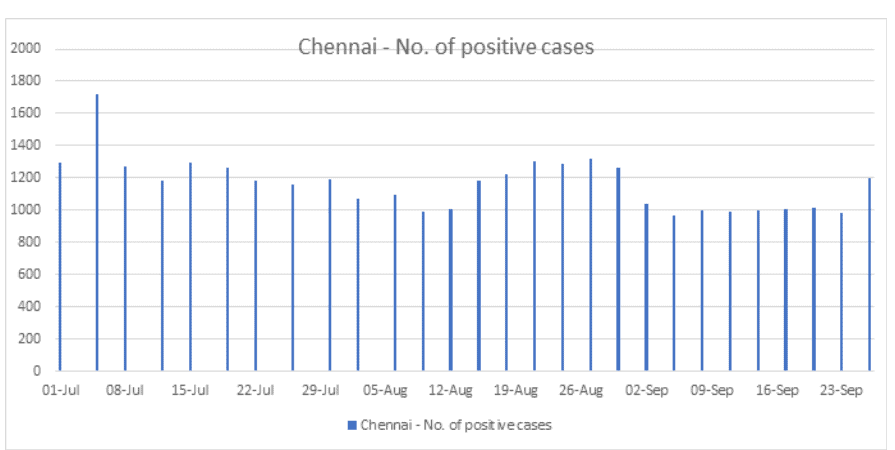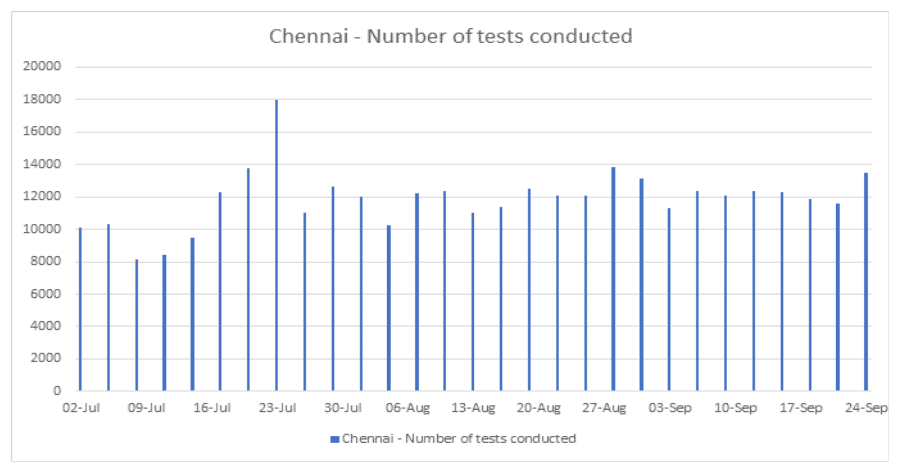If you look at the last six months, Chennai has adopted a strategy that in some ways is similar to other large cities in the country: go into intense lockdown, lift some restrictions and back into selective lockdown again. Chennai has spent more days under intense lockdown than any other large metropolitan city in the country. While it’s technically still under lockdown, there have been significant relaxations that could see further easing over the next few weeks, but the incidence of cases in the city hasn’t caused any big spikes in the recent weeks.

An overview of figures from the country shows Delhi, Maharashtra and Tamil Nadu as the biggest hotspots, contributing to India having the largest number of cases on a daily basis for the past couple of weeks. In terms of numbers for states as a whole, Tamil Nadu is amongst the top five when it comes to the number of positive cases.
As of September 26th, the state had recorded more than 5.8 lakh confirmed cases with Chennai accounting for a majority of those, with more than 1.6 lakh cases. The death toll in the state is more than 9000.
The growth rate of cases in the state has steadily increased over the past two months. In the initial months of the pandemic, particularly in April and May, testing per capita was very low. Until mid-May, not more than 85,000 tests were conducted.
This was also at a time when thousands of migrant workers were looking for a way to leave the state to return to their homes. With lack of any proper planning and accommodation for them, crowded scenes at transport hubs were commonplace. This posed an increased risk for a local outbreak.
Testing to identify, isolate and contain
Testing was always, and continues to be, important. It’s the foundation on which a plan to reopen and ease restrictions can be based on. The amount of testing being done has increased significantly, especially over the past two months. A higher testing rate means it’s easier for authorities to identify COVID positive persons, possible and emerging hotspots and clusters. This allows officials to implement effective containment strategies and conduct contact tracing.
Tamil Nadu has now tested more people than any other state in the country with over 58 lakh tests since the beginning of the pandemic. A majority of those were in the past 3 months.

Over the past few weeks, the number of cases in Chennai has plateaued, but hasn’t diminished significantly. An encouraging sign is that with increased testing and a lower positivity rate, it becomes easier to identify hotspots. Take one of the early hotspots in the city, Royapuram; the average number of cases in June were 800 a week. As of late July, that number came down to about 300.
The strategy employed involved several steps. First and foremost was testing, to identify and isolate. The Chennai Corporation employed thousands of volunteers to conduct door-to-door surveys for temperature and oxygen level checks across the city. The second involved conducting fever camps in zones that are deemed to be high risk – slums and densely populated areas. As part of this, surveys were also conducted to identify high risk zones, i.e. ones which have a high population of senior citizens for example.
As of early September, more than 41,000 such camps have been conducted which have resulted in identifying more than 1.3 lakh cases. According to the Chennai corporation, Anna Nagar, Teynampet, Thiru.Vi.Ka Nagar had more than 4000 camps.
Since the beginning of September, the number of containment zones has come down. In fact, the Chennai corporation has now designated that there is no need to declare any area a containment zone as of now, the reason being that the case count has come down significantly. While prior protocol called for an area to be cordoned off given the number of cases, now officials only monitor specific individuals who are under home isolation.
While Chennai has followed this approach consistently and the resulting decline in positivity rate is a good sign, a concern remains in respect of nearby districts such as Thiruvallur, Cuddalore and Chengalpattu, which are contributing to the overall state tally on a daily basis. In many of these districts, testing data isn’t available as the government hasn’t made that information public yet. It is vital to make testing widely available in these areas, as travelling between districts is now sanctioned.
Reopening will only work with a combination of testing and compliance
A sero survey by the Chennai Corporation stated that one-fifth of the city’s population has been exposed to COVID-19. The red zones from this survey were Tondiarpet, Royapuram and Thiruvottriyur, all having more than 30% positivity rate from the samples collected for the survey. Given the population density in these areas, the numbers make sense, but it’s important to remember that a vast majority of the city’s population are still susceptible to the virus.
Some of the commercial hubs in the city like T Nagar and Usman Road opened in May after a government directive allowing them to operate under strict guidelines. Another main commercial hub in the city, Ritchie street, which sells electronics, closed early and only opened in the final week of May. Now, so many months later, we are at a stage where most businesses and institutions are looking at opening up, subject to central and state guidelines.
What Chennai cannot afford is a repeat of a Koyambedu market which turned out to be a local hotspot. Just because testing has improved, residents and the government cannot afford to do away with guidelines.
Herd immunity is still not possible in the country as a whole according to an ICMR survey. With a record number of daily cases nationwide, it still stands that the more people are vulnerable. For herd immunity to be attained, close to 65-70% of the population would test positive. This hasn’t happened and according to the survey, a vaccine remains the best solution to contain the spread.
If schools and colleges are to be opened, as is being mulled over, there needs to be a separate robust testing strategy in place to test students and staff as schools are easily crowded and pose a high risk. Dr. V Ramasubramanian, one of the experts who has been advising the state government summed up the current testing situation, “The more people we track and isolate, lesser the transmission rate. Chennai should be the epicentre of testing.”